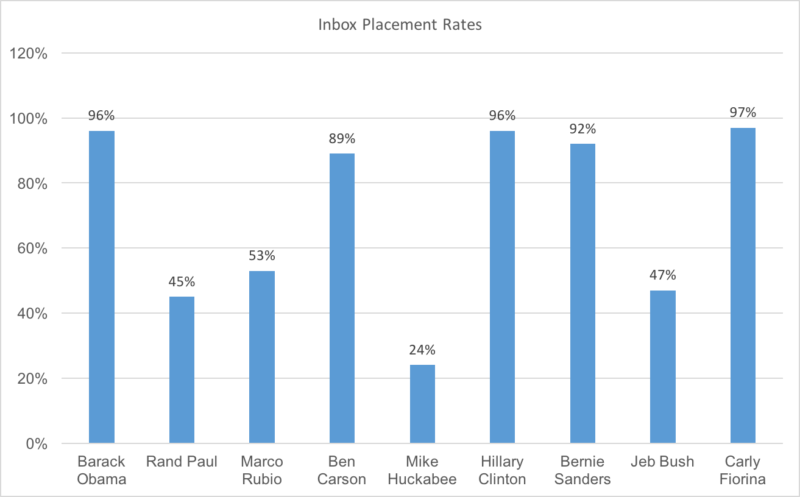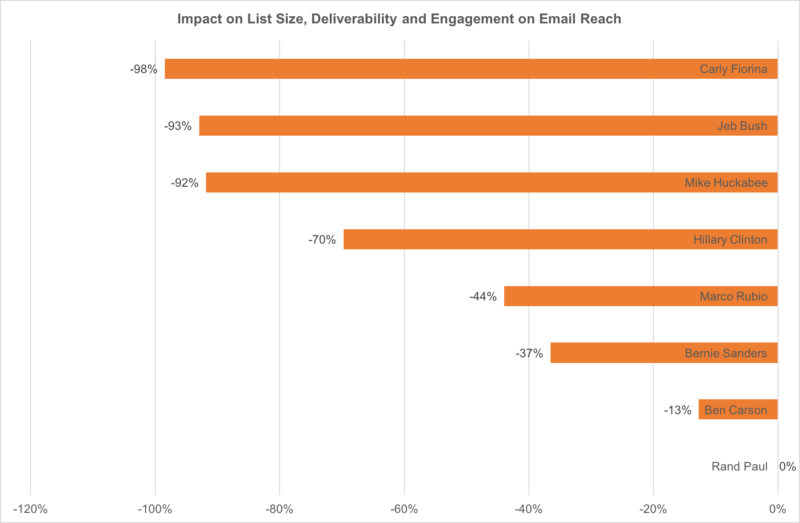Why These Email Marketing Tactics Are Important For The Presidential Campaigns (And Your Email Campaigns, Too)
In the first of this four-part series, columnist Tom Sather reveals three key factors in determining a successful email marketing strategy.

The star of the 2012 presidential campaign and election wasn’t Barack Obama, but rather his email marketing strategy, which purportedly raked in more than $500 million in online donations alone. Obama’s email team accomplished this amazing feat by following some basic email marketing principles.
In my first post in a four-part series detailing how the presidential hopefuls are using email as their path to the White House, I’ll lay out three of the most important factors in determining a successful email marketing strategy: list size, inbox placement and engagement.
I’ll look at the email campaigns sent in May 2015 for those who have announced their candidacy so far — Hillary Clinton (D), Bernie Sanders (D), Rand Paul (R), Ted Cruz (R), Marco Rubio (R), Ben Carson (R), Carly Fiorina (R), and Mike Huckabee (R) — to see who’s winning and reaching the most subscribers with these email marketing tactics. [Editor’s note: Rick Santorum also recently announced his candidacy, but Return Path has not yet analyzed the data for his email campaign.]
Size Matters
The subscriber list is the most important asset for email marketers. In 2012, Obama commanded an email audience five times larger than his competitor.
As an owned channel, email is significantly more effective at driving conversions than other forms of paid media, and it’s also significantly cheaper. Email is also permanent until the subscriber performs an action, which is unlike social channels where algorithms determine when and if a message is displayed in one’s social feed.
A larger email audience provides a better platform to raise donations and also to get the word out to vote as the election nears.
WINNER: Rand Paul
Paul wins this category with the largest email audience than the other candidates. Using Paul as the baseline and comparing the list size of the others who have announced their run for president, you can see just how far the others have to go to build their audience.
The good news is that it’s still early. If email list size and the 2012 election were any indicator of success, then Paul has the upper hand. The bad news is Obama has an email list size 296% greater than Paul’s.
Four Republican contenders have email lists that are greater than either of the Democrats running for president. Only Jeb Bush, who is formally exploring a candidacy, and Fiorina, fared worse.
Again, it’s early, and technically each party is trying to elect one person from their party to the presidential ticket. Once each party selects a nominee, expect them to spend a great deal in growing their audiences from email to social and beyond.

Source: Return Path
Deliverability Matters
For email audience growth, bigger may be better, but there’s one thing that will make any email campaign less effective – poor deliverability. Deliverability, or the ability to reach the inbox, can be affected by everything from content, poor list quality, lack of engagement, or a poor sending reputation.
Since most of these candidates are sending from relatively new IP addresses, sending history, or lack thereof, is a factor in determining one’s sending reputation, so it’s not surprising to see some deliverability issues this early on.
WINNER: Hillary Clinton
Looking at the month of May, Clinton had the highest inbox placement rate (96%). Fiorina receives an honorable mention with 97% of her campaign emails reaching her subscribers’ inboxes, but, considering how much smaller her subscriber list size is and how infrequently she sends (only three emails in May), her reach is significantly lower than the others.
Republicans Paul and Rubio may have had a greater sized list compared with the others, but the effectiveness of a larger email audience wanes as they struggle to reach the inbox. Over half (55%) of Paul’s email campaigns are delivered to the spam folder, and nearly half (47%) of Rubio’s emails see the same treatment.
Huckabee, who had an email list larger than either of the Democratic hopefuls, saw his email reach lower than either Clinton or Sanders.

Source: Return Path
Taking this into account when calculating audience reach, Paul still maintains the No. 1 position, as his list was originally so much greater than all the others running for president. However, Carson moves to second place thanks to inbox placement rates higher (89%) than all other Republican presidential hopefuls, with the exception of Fiorina.
Clinton moves to third place thanks to a high inbox placement rate, despite a comparatively smaller list than the others. Huckabee, who had the third-largest list, saw his inbox influence decline as a result of abysmal deliverability problems, and moved to the bottom three in the list.

Source: Return Path
Engagement Matters
Best-in-class marketers pay attention to how many of their emails reach the inbox because they know how much of an effect it has on engagement rates, or in particular how many emails sent that were opened. Very few subscribers take the time to wade through the spam filter to look for emails unless they are extremely important, which are primarily transactional-type emails.
WINNER: Carly Fiorina and Bernie Sanders
If we were to go solely off the rate of which emails are read by subscribers, the winner would be Fiorina with 31% of her three email campaigns sent being read. If we removed Fiorina due to a small sample size, Sanders would pick up the No. 1 spot (26% read rate) followed by Clinton (22% read rate). Rubio (9%), Bush (7%), and Huckabee (4%) make up the bottom three based on amount of emails read.
In comparison, Obama has a read rate of 10%, below the average read rate of 14% for those currently running for president, but Obama has also been emailing us every day over the past six-plus years, and his list is likely seeing fatigue.

Source: Return Path
While email opens are extremely important, they are but one metric we measure to reach our final goal. In the case of the presidential hopefuls, the main goal right now is to increase campaign donations.
What if we took all things being equal and each presidential hopeful sent one campaign to their entire list? How would list size, deliverability and read rates impact total reach for each candidate, and who would we say was likely the most effective at raising donations if we looked at how many subscribers were opening and reading their emails?

Source: Return Path
Paul, despite his low inbox placement rates and below-average rates, still manages to reach the most subscribers, all thanks to having a greater sized list than the others. Carson places second, falling just 13% below Paul’s reach. In this scenario, Sanders moves to the No. 3 (37% below Paul’s reach), and Rubio comes in at No. 4, reaching and engaging 44% less people than Paul.
The size of your subscriber list is extremely important, and deliverability and engagement can positively or negatively offset the impact of the size of your list. In the case of Paul, having a mammoth-sized list still means reaching more people despite an extremely low 45% inbox placement rate, and a ho-hum 12% read rate.
On the other hand, Sanders may have had a much smaller subscriber list than the others, but high deliverability rates (92% inbox placement rate) and high engagement (26% read rate) could mean more donations, especially against a household figure like Clinton, with more money and a larger email list in her favor.
2008 may be a lot like 2016 in that Clinton may find herself losing to the underdog thanks to a more effective email strategy.
Stay tuned for the next part of this series in which we’ll examine the effectiveness and use of other tactics like subject line testing, body copy testing, frequency and more.
Contributing authors are invited to create content for MarTech and are chosen for their expertise and contribution to the search community. Our contributors work under the oversight of the editorial staff and contributions are checked for quality and relevance to our readers. MarTech is owned by Semrush. Contributor was not asked to make any direct or indirect mentions of Semrush. The opinions they express are their own.
Related stories